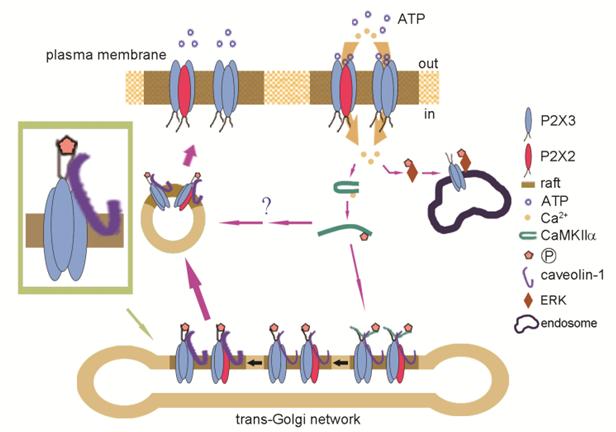
CaMKIIα and Caveolin-1 Cooperate to Drive ATP-induced Membrane Delivery of P2X3 Receptor
May 04, 2014 Email"> PrintText Size

The ATP-gated ion channel P2X3 receptor, which is abundantly expressed in primary sensory neurons, plays an important role in inflammation and neuropathic pain. The assembly and trafficking of the P2X3 receptor are important for its function in primary sensory neurons. Under pathological pain conditions, various inflammation mediators including ATP are released from different cell types around primary sensory neurons and regulate the function of the P2X3 receptor. ATP has been shown to promote the internalization of the P2X3 receptor and formation of P2X3 receptor-containing "signaling endosome”, which was retrogradely transported to the cell bodies of primary sensory neurons to regulate the activation level of transcription factor CREB and neuronal excitability, but ATP-mediated forward trafficking of the P2X3 receptor and its related molecular mechanisms have not been fully clarified.
A group of researchers led by Prof. BAO Lan at the Institute of Biochemistry and Cell Biology, Shanghai Institutes for Biological Sciences provided the first evidence that α, β-MeATP dramatically promoted membrane delivery of the P2X3 receptor both in HEK293T cells expressing recombinant P2X3 receptor and in rat primary sensory neurons. CHEN Xuqiao, under the supervision of Prof. BAO Lan, found that α, β-MeATP induced P2X3 receptor-mediated Ca2+ influx, which further activated Ca2+/calmodulin-dependent protein kinase IIα (CaMKIIα). The N terminus of the P2X3 receptor was responsible for CaMKIIα binding, whereas Thr388 in the C terminus was phosphorylated by CaMKIIα. Thr388 phosphorylation increased P2X3 receptor binding to caveolin-1. Caveolin-1 knock down abrogated α, β-MeATP-induced membrane insertion of the P2X3 receptor.
Moreover, α, β-MeATP drove the CaMKIIα-mediated membrane coinsertion of the P2X2 receptor with the P2X3 receptor. The increased P2X3 receptors on the cell membrane that are due to Thr388 phosphorylation facilitated P2X3 receptor-mediated signal transduction. These data indicate that CaMKIIα and caveolin-1 cooperate to drive ligand-induced membrane delivery of the P2X3 receptor and may provide a mechanism of P2X3 receptor sensitization in pain development.
This work entitled “CaMKIIα and caveolin-1 cooperate to drive ATP-induced membrane delivery of the P2X3 receptor” was published online in Journal of Molecular Cell Biology on Mar 23, 2014.
This study was supported by grants from the National Natural Science Foundation of China (30930044) and National Basic Research Program of China (2010CB912001 and 2014CB942800).

A schematic diagram showing the ATP-induced membrane delivery of the P2X3 and P2X2/3 receptors. (Image by Prof. BAO Lan’s group)
CONTACT:
BAO Lan
Institute of Biochemistry and Cell Biology, Shanghai Institutes for Biological Sciences, Chinese Academy of Sciences,
Shanghai, China
Phone:86-21-54921369;
E-mail: baolan@sibcb.ac.cn
The ATP-gated ion channel P2X3 receptor, which is abundantly expressed in primary sensory neurons, plays an important role in inflammation and neuropathic pain. The assembly and trafficking of the P2X3 receptor are important for its function in primary sensory neurons. Under pathological pain conditions, various inflammation mediators including ATP are released from different cell types around primary sensory neurons and regulate the function of the P2X3 receptor. ATP has been shown to promote the internalization of the P2X3 receptor and formation of P2X3 receptor-containing "signaling endosome”, which was retrogradely transported to the cell bodies of primary sensory neurons to regulate the activation level of transcription factor CREB and neuronal excitability, but ATP-mediated forward trafficking of the P2X3 receptor and its related molecular mechanisms have not been fully clarified.
A group of researchers led by Prof. BAO Lan at the Institute of Biochemistry and Cell Biology, Shanghai Institutes for Biological Sciences provided the first evidence that α, β-MeATP dramatically promoted membrane delivery of the P2X3 receptor both in HEK293T cells expressing recombinant P2X3 receptor and in rat primary sensory neurons. CHEN Xuqiao, under the supervision of Prof. BAO Lan, found that α, β-MeATP induced P2X3 receptor-mediated Ca2+ influx, which further activated Ca2+/calmodulin-dependent protein kinase IIα (CaMKIIα). The N terminus of the P2X3 receptor was responsible for CaMKIIα binding, whereas Thr388 in the C terminus was phosphorylated by CaMKIIα. Thr388 phosphorylation increased P2X3 receptor binding to caveolin-1. Caveolin-1 knock down abrogated α, β-MeATP-induced membrane insertion of the P2X3 receptor.
Moreover, α, β-MeATP drove the CaMKIIα-mediated membrane coinsertion of the P2X2 receptor with the P2X3 receptor. The increased P2X3 receptors on the cell membrane that are due to Thr388 phosphorylation facilitated P2X3 receptor-mediated signal transduction. These data indicate that CaMKIIα and caveolin-1 cooperate to drive ligand-induced membrane delivery of the P2X3 receptor and may provide a mechanism of P2X3 receptor sensitization in pain development.
This work entitled “CaMKIIα and caveolin-1 cooperate to drive ATP-induced membrane delivery of the P2X3 receptor” was published online in Journal of Molecular Cell Biology on Mar 23, 2014.
This study was supported by grants from the National Natural Science Foundation of China (30930044) and National Basic Research Program of China (2010CB912001 and 2014CB942800).

A schematic diagram showing the ATP-induced membrane delivery of the P2X3 and P2X2/3 receptors. (Image by Prof. BAO Lan’s group)
CONTACT:
BAO Lan
Institute of Biochemistry and Cell Biology, Shanghai Institutes for Biological Sciences, Chinese Academy of Sciences,
Shanghai, China
Phone:86-21-54921369;
E-mail: baolan@sibcb.ac.cn
CAS Institutes
There are 124 Institutions directly under the CAS by the end of 2012, with 104 research institutes, five universities & supporting organizations, 12 management organizations that consist of the headquarters and branches, and three other units. Moreover, there are 25 legal entities affiliated and 22 CAS invested holding enterprisesThere are 124 I...>> more
Contact Us

Chinese Academy of Sciences
Add: 52 Sanlihe Rd., Xicheng District, Beijing, China
Postcode: 100864
Tel: 86-10-68597592 (day) 86-10-68597289 (night)
Fax: 86-10-68511095 (day) 86-10-68512458 (night)
E-mail: cas_en@cas.cn

